Updated in Nairobi, Kenya, Tuesday, April 22 at 00:06.
I posted this Cuba blog yesterday, and have received more than a dozen emails with reactions——a variety of them, of course. I single one out, from my fellow Cuban American, Ina Esteva, a Miami-based teacher and artist, with whom I went to high school at Miami Senior High School:
Interesting blog, Mario. I enjoyed it, but I would like for all the conversations about a new Cuba NOT to deal with such topics as tourism and travel, while we need to be talking about education, health, the environment and, most importantly, re-educating a people who have not seen the light for 50 years, and who don’t know the meaning of freedom in any of its definitions. They are used to lies. A people who have had to, in a sense, prostitute themselves, to survive, will take a long time to reeducate into the ways of democracy, a free economy and a free press. And, Mario, let’s not forget what your parents and mine brought us to the United States for, and their goal for Cuba was a FREE CUBA, so one with the Castro brothers still in charge, not so sure.

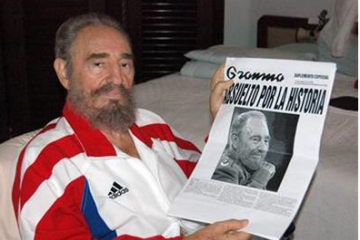
The “líder maximo” reads one of his own articles in Granma newspaper: Fidel Castro is the writer, the reader, the publisher, and the front-page lead piece! Nice work if you can get it.

A ‘real” Cuban reader enjoys his newspaper with all the news that the publisher, above, considers fit to print and to be consumed.
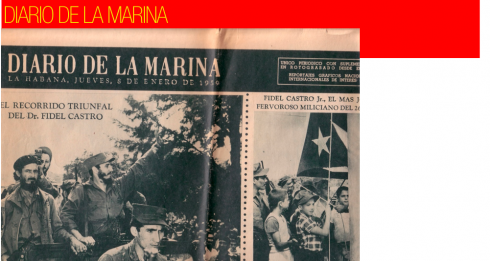
This was the newspaper that my grandfather, Juan Antonio Suarez, used to read everyday. I remember looking over his shoulder as he read it.
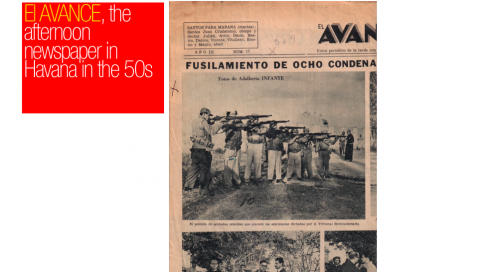
Avance was one of Havana’s afternoon newspapers
This is a blog entry about at least three powerful and non negotiable IFS, a dozen MAYBES and half a dozen HOPE SOs. And, before you write to tell me, let me be the one telling you this is not an objective piece. Hard to be objective when you found yourself out of your country at 14, landing in a country where you did not know the language, without your parents, and all because of political circumstances that marked you for life. Take this as what it is, an opinion piece, somewhat analytical, from a person who has traveled the world and six continents doing my work, but for whom the whole Cuban thing has always had the emotional proximity that means more than the geographical 90 miles away and who, for the first time in almost 50 years, recognizes that it may be possible still for someone like me to do work in a new Cuba. But let’s deal with the IFS first.
Here are the IFS:
IF President Obama can truly engage the Cuban government in some type of civilized, well intentioned, sensible discussion of how relations between the United States and Cuba could get a strong slap on the fanny to get them going again.
IF Raul Castro, the Cuban president, means what he says when he sends a message to the Americans that he is ready to talk about the three biggies: human rights, freedom of the press, free travel for the long oppressed Cuban population.
IF as part of the new discussions, multi party elections enter the picture.
For the first time: cautious hope
However, I have to admit that in the 47 years since I left Cuba as a child, this is the first time that I have seen myself perhaps sitting in a Havana cafe, contemplating my surroundings, and maybe even playing a role in how the new Cuban media shapes up when freedom shines on it. And it is a fabulously interesting thought, the type that grabs you and won’t let go.
No, I am not packing my Tumi suitcase to board the next flight out to Cuba yet, and tons of IFS have to become YES before that happens.
However, a year ago, I never thought I would see me planting my feet—-or doing a run, for that matter——on that most beautiful of landscapes. However, this morning as I ran thru the center of Zurich, I had fantasies of a run under las palmas reales the royal palms of which Cuba has the tallest and the most beautiful, or at least that is how my childhood memories captured them.
Writing about Cuba is not, and has not been, one of my priorities. The last time I wrote about Cuba in a political context was a column for USA Today, Jan. 24, 2000, titled “Letter to Elian Gonzalez”, at the time of the controversy over the young Cuban boy who had been rescued at sea (where his mother died) while trying to come to Florida.
Why the interest today?
No matter which medium one turns to this weekend, all the news is about Obama’s participation in the Organization of American States meeting in Trinidad-Tobago, and the protagonist role that Cuba—-the one Latin American country not a member of the OAS—-has played.
In Sunday’s New York Times, a lead piece headlined Rising Expectations on Cuba Follow Obamareports that “An exchange of conciliatory overtures between President Obama and President Raúl Castro of Cuba has started a buzz of speculation about more substantive dialogue. And the crack in the door Mr. Obama had opened for new engagement with Cuba felt more like unlocking a floodgate.”
A floodgate, indeed, at various levels——from the domino players sitting al fresco next to a cafe in Miami’s Little Havana and Calle Ocho, to the editorial columns of newspapers worldwide (at least the majority of the ones in Europe advise Obama to go for it, to grab the opportunity and to stay away from old, tired policies that have yielded no good results), to, I am sure, the hotel/airline/tourism business which see green ahead if Cuba becomes the destination of choice, as it was decades ago, for millions of Americans.
The media landscape
My main interest is how the media reshuffle will play out in Cuba.
Correction, it is not a reshuffle. It is a renaissance. One must start from scratch there. Lots has been written about the press in a Post Castro Cuba. But, obviously, we are not looking at life after the Castro brothers leave power—-if that glorious day ever comes. That was Scenario A, ladies and gentleman.
We are faced with Scenario B, which is what I understand is playing here. Obama and Raul Castro talk to each other, Castro makes good on his promise to discuss human rights (perhaps free political prisoners—-a MUST), establish a free press, and curtail travel restrictions. The unsinkable Castro Brothers stay at the helm—-Fidel, the decrepit sick one, writing long essays for the also decrepit newspaper Granma, from his bed, while Raul, in spiffy suits and pastel ties, runs the government. For younger Raul, this may be his last chance to approach the center of the dance floor and do a few Alicia Alonso pirouettes with the Americans. At 76, he does not have much time left, and, unlike his brother Fidel, he does not have the talent for long winded speeches and manifestos. Maybe he is good at quick, sensible, history-changing dialog. If I were him, I would be asking Alicia to lend him a tutu pronto, along with her best ballerina shoes, since this may require some “on your toes” routines.
One of the most interesting “media after Castro” pieces I have encountered is one by journalist Iris Cepero, titled Anna Politkovskaya——, particularly those who denounce the Russian government for crimes in Chechnya, are other characteristics of the current Russian model.
As expected, there is heavy concentration of the media in the hands of government supporters. Gazprom, the gas conglomerate which is extremely close to the Kremlin, has acquired via its ‘media’ subsidiary a number of national and regional daily newspapers, including Kommersant, which was considered one of the last bastions of the independent press. Cepero’s article mentions that the company has declared that it plans to acquire Komsomolskaya Pravda, the country’s leading newspaper (2.1 million readers daily).
In terms of design, however, several Russian dailies and magazines have used the new wave of freedom (restricted as it may be) to experiment with visual presentations that have pushed them to the forefront globally, including , Akzia, a Moscow biweekly, chosen among the top best designed newspapers in the Society of Newspaper Design contest.
How about the American model?
Of course, we know that American newspapers are in trouble, and that their business models are part of the reason (not the only one) that they find themselves in such dire financial straits. However, Cubans in the pre-Castro era loved everything American.
As a child, I don’t know how many times I heard my father and my uncles sing the praises of anything Made in the USA—from pianos, to refrigerators, to television sets. Cubans were always proud that they were the first to get television after the United States. Frank Sinatra, Nat King Cole, Ella Fitzgerald were all staples of the Tropicana Night Club.
So, it is likely that Cubans will learn from the recent stories of the American newspapers and media companies, and will create models that will emphasize multi media platforms from the go. With one exception, if I may offer advice: don’t produce any broadsheets. Go compact all the way.
The rise of independent journalism in Cuba
I believe that a transition on the part of Cuban journalists will be easier. Already we see the rise of independent journalism in Cuba has followed the rise of the Internet, with independent media professionals filing their stories by fax and phone dictation to editors in the United States. There are 100-odd independent reporters in Cuba who have given the world an alternative view of pro-communist propaganda published by the island’s official press corps
Let’s not forget that Cuba has already produced an award winning blogger, Yoani Maria Sanchez Cordero, who writes about the daily struggles of Cubans to survive.
One may suspect that there are many other Yoanis in the Cuba of today, waiting for the opportunity to spread their message, something that a totally free press will surely offer them. They, a total product of the Castro revolution, long for what comes naturally: freedom of expression. Years of indoctrination have not been able to inculcate the opposite in their minds.
Yoanis, born in 1975, is the most famous example.
The Spanish Model
The creation of a new media in a country that allows for freedom of the press after years of journalists living in a dark cave brings to mind the case of Spain.
With the death of Dictator Francisco Franco in 1975, Spain emerged from one of the darkest periods of dictatorship in its history. A free press was ready to start. El Pais appeared in 1976, as an elegant tabloid. Soon, one by one, the huge broadsheets that reminded everyone of the Franco era turned to tabloids. There are no broadsheets in Spain. At the same time, the new infusion of freedom opened the doors for creativity in every field from design to cinematography to literature. It is no wonder that Spain continues to have the best designed newspapers per capita of any country in the world. It was the late 1970s, Spain was breathing the airs of new freedom; journalists started flexing their muscles; designers, who had been working mostly in the design of books, shifted to newspapers, and brought with them styles that newspapers had never seen before.
This is my hope for the new media of a free Cuba. A country which historically has produced the most talented authors, artists, musicians, cinematographers and journalists will seize the opportunity con mucho gusto.
It is a good, but rare feeling, to think that one can be part of this historic moment.
Now we have to wait for all the IFS to be mutually satisfied by the two countries and their governments.
In that case, some of the MAYBES can turn into reality, and our HOPES—-the ones that lingered there and we never thought much about, but which are at the forefront today——can translate into a fantastic platform to tell the story of the new Cuba.
It’s been a long time coming. Some of us are elated to be around to savor it.
Seminar for Newspapers, Magazines in Paris
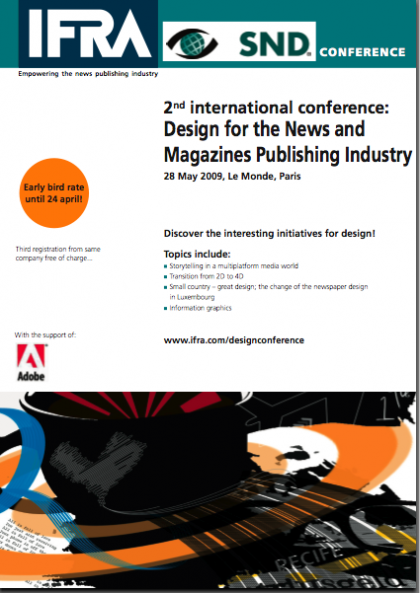
IFRA is sponsoring a one-day seminar May 28 in Paris titled “Design for the News and Magazines Publishing Industry”.
I will be one of the speakers, addressing the topic of Storytelling in a multiplatform media world. Other topics include: Transition from 20 to 40; Small country, great design: the change of the newspaper design in Luxemburg, and informational graphics.
Those interested should go to www.ifra.com/designconference.
Early bird rate until April 24.
Marketing and Luxemburg’s L’Essentiel
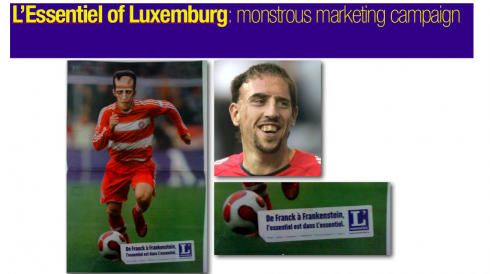
Photo courtesy of Frank Deville
The free-distribution French language newspaper of Luxemburg has unveiled a marketing campaign which displays this image of Franck Riberya French football midfielder who plays for the German Bundesliga club Bayern Munich. In the ad, the newspaper has superimposed an image of Frankenstein to the body of Ribery. The headline reads: From Franck to Frankenstein,the essential is inside L’Essentiel..
When Ribéry was two years old, he and his family were involved in an automobile accident in Boulogne-sur-Mer after colliding with a truck. Ribéry suffered serious facial injuries that resulted in over one hundred stitches and left two long scars down the right side of his face. This is why some readers have objected to the use of his image in this ad for the newspaper.
Frank Deville, a former professional football player for the Luxemburg National Team, as well as in Germany, had this to say:
I am sorry, but I find this advertisement to be in terribly bad taste. Everyone knows that Ribery has bad scars on his face as a result of an accident when he was a child. So to use him in this connection is, to me, very bad. I cannot imagine that Ribery agreed to allow his image to be used in this way.
We also cannot imagine any newspaper building a marketing campaign around a well known personality like Franck Ribéry, without first getting his approval. We would like to think that player Ribéry agreed to be a good sport about the use of his photo here!
Stay tuned.
TheMarioBlog posting #243